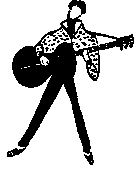Teach Yourself Jazz - online guidebook
For the beginning player, with sheet music samples
| Share page | Visit Us On FB |
|
CHAPTER THIRTEEN
REVIVALISM
BACK TO TRADITION |
 |
||
|
The big-band swing era pushed two things into the foreground: brilliance of band technique, as shown in drive, precision, volume of sound and virtuosity of individual soloists; and brilliance of star players, as shown in dexterity, lung-power and ability to hit high notes. Sometimes the music itself tended to be forgotten; no wonder that, before long, one or two musical souls began to yearn for the New Orleans days where music as an expression of human feeling was more important than individual display or band showmanship.
One of the pioneers of the revivalist movement was the West Coast white jazzman Lu Watters who, in 1939, formed his Yerba Buena Jazz Band (named after the Yerba Buena Island in San Francisco Bay where Watters first played). This outfit started to play in the style of Oliver and Armstrong: in the early '40s they were engaged to play regularly at the Dawn Club. At first, their experiment drew little attention, and it was almost abandoned as a flop; but gradually audiences began to grow, the news
93 |
|||